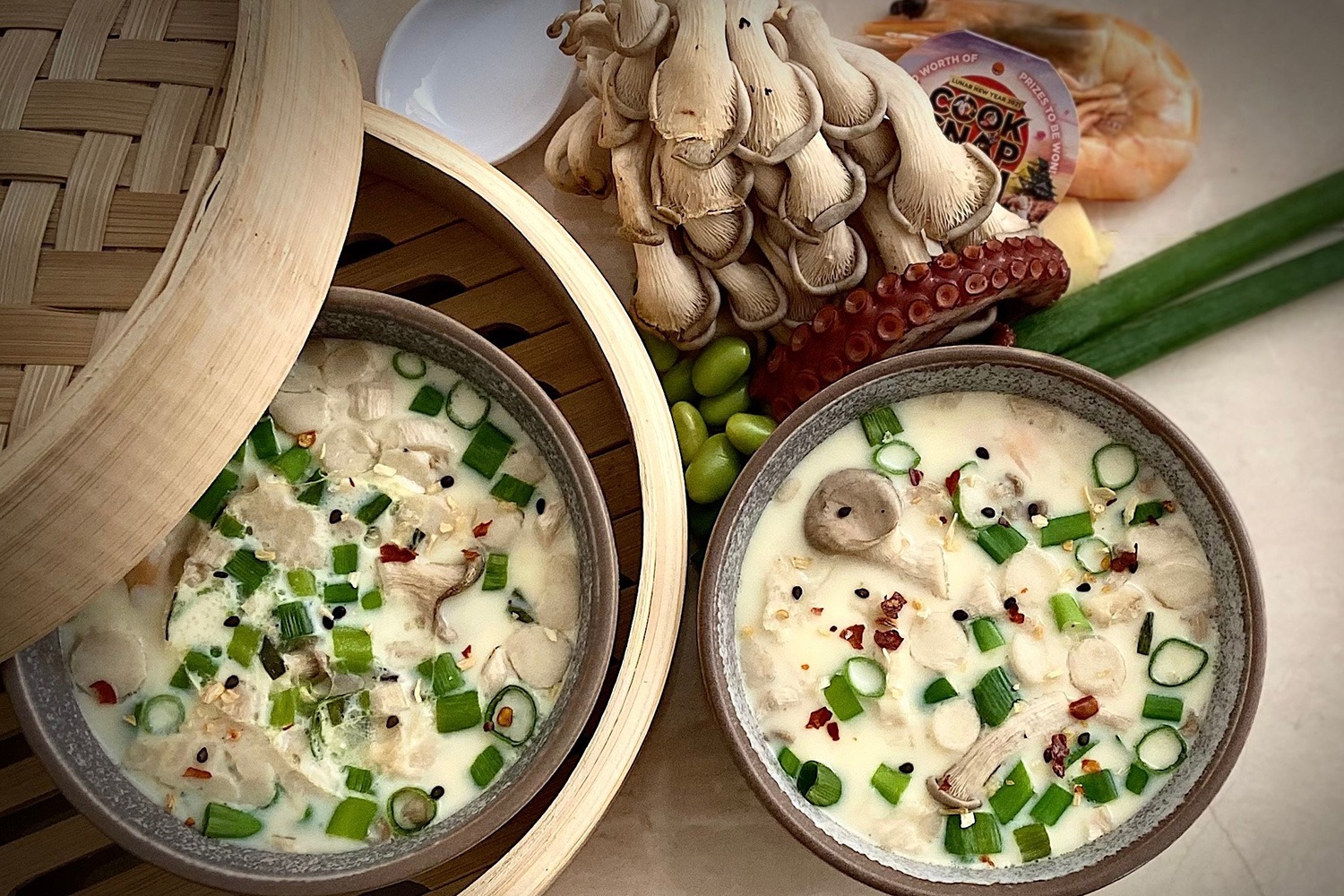Table of Contents
ToggleChawanmushi is a traditional Japanese dish that showcases the elegance and simplicity of Japanese cuisine. This savory steamed egg custard, often served as an appetizer or side dish, is known for its silky texture and delicate flavor. Its name, “chawanmushi,” translates to “steamed in a teacup,” reflecting the traditional method of steaming the custard in small cups. This article explores the history, ingredients, preparation methods, variations, and cultural significance of chawanmushi.

History and Origins
Chawanmushi has been a staple of Japanese cuisine for centuries, with roots tracing back to the Edo period (1603-1868). During this time, the dish was commonly served in banquet-style meals known as kaiseki, which feature a series of small, artistically prepared dishes. Kaiseki cuisine emphasizes seasonality, balance, and presentation, and chawanmushi fits seamlessly into this culinary tradition.
Originally, chawanmushi was considered a luxurious dish, enjoyed primarily by the elite. Over time, however, it became more accessible and popular among all levels of society. Today, it remains a beloved component of both traditional and modern Japanese dining.
Ingredients
Chawanmushi is made with a simple yet flavorful base of eggs and dashi (Japanese soup stock). The beauty of the dish lies in its versatility, as it can incorporate a variety of ingredients based on personal preference and seasonal availability. Common ingredients include:
- Eggs: The foundation of chawanmushi, providing the custard-like texture.
- Dashi: A flavorful stock made from kombu (dried kelp) and katsuobushi (dried bonito flakes), essential for authentic Japanese flavor.
- Soy Sauce: Adds umami and depth to the custard.
- Mirin: A sweet rice wine that balances the savory elements.
- Salt: Enhances the overall flavor.
Common Additions
- Chicken: Small pieces of chicken are often included for added protein and flavor.
- Shrimp: Fresh or cooked shrimp provide a delicate seafood taste.
- Mushrooms: Shiitake mushrooms are commonly used for their earthy flavor and texture.
- Ginkgo Nuts:
Ginkgo nuts are a traditional addition that adds a slight bitterness and a unique texture.
- Kamaboko: A type of Japanese fish cake, typically pink and white, which adds both flavor and visual appeal.
- Yurine: Lily bulbs that add a subtle sweetness and a starchy texture.
Preparation and Cooking Methods

The preparation of chawanmushi requires a careful balance of ingredients and precise cooking techniques to achieve the desired silky texture. Here is a step-by-step guide to making chawanmushi:
Step 1: Prepare the Dashi
- Ingredients:
- 1 piece of kombu (about 10 cm)
- 2 cups of water
- 1/2 cup katsuobushi
- Instructions:
- Soak the kombu in water for at least 30 minutes.
- Heat the water and kombu over medium heat until just before it starts to boil. Remove the kombu.
- Add the katsuobushi and bring to a boil. Turn off the heat and let it sit for a few minutes.
- Strain the dashi through a fine mesh sieve or cheesecloth.
Step 2: Prepare the Custard Base
- Ingredients:
- 2 large eggs
- 1 cup dashi
- 1 tsp soy sauce
- 1 tsp mirin
- Pinch of salt
- Instructions:
- Beat the eggs gently to avoid creating too many bubbles.
- Mix the dashi, soy sauce, mirin, and salt into the beaten eggs.
- Strain the mixture through a fine mesh sieve to ensure a smooth custard.
Step 3: Prepare the Additions
- Ingredients:
- Small pieces of chicken (cooked or raw)
- Shrimp (peeled and deveined)
- Shiitake mushrooms (sliced)
- Ginkgo nuts (cooked)
- Kamaboko (sliced thinly)
- Instructions:
- Distribute the chicken, shrimp, mushrooms, ginkgo nuts, and kamaboko evenly into chawan (small cups).
Step 4: Steam the Chawanmushi
- Instructions:
- Pour the custard base over the yowestogel additions in each cup.
- Cover each cup with a lid or aluminum foil to prevent water from dripping into the custard.
- Place the cups in a steamer. If using a stovetop steamer, bring the water to a gentle boil.
- Steam on low heat for about 15-20 minutes, or until the custard is set but still jiggles slightly when shaken.
- To test doneness, insert a toothpick into the center. If clear liquid comes out, it’s done.
Step 5: Serve
- Instructions:
- Serve the chawanmushi warm or at room temperature.
- Garnish with small sprigs of mitsuba (Japanese parsley) or a dash of yuzu zest for added flavor and presentation.
Variations of Chawanmushi

Chawanmushi is highly versatile, and many variations exist based on regional preferences and seasonal ingredients. Some popular variations include:
- Kani Chawanmushi: Made with crab meat for a luxurious twist.
- Uni Chawanmushi: Incorporates sea urchin, adding a rich and creamy flavor.
- Vegetarian Chawanmushi: Uses a combination of vegetables like bamboo shoots, carrots, and spinach.
- Seafood Chawanmushi: Combines various seafood such as scallops, fish, and clams.
Cultural Significance
Chawanmushi is more than just a dish; it represents the essence of Japanese culinary philosophy, which emphasizes harmony, balance, and seasonality. It is often served during special occasions and is a staple in kaiseki cuisine, a traditional multi-course meal that highlights the artistry and precision of Japanese cooking.
The preparation and consumption of chawanmushi can be seen as a meditative practice, where each step is performed with care and attention to detail. This reflects the Japanese concept of “ichigo ichie,” meaning “one time, one meeting,” which encourages mindfulness and appreciation for the present moment.
Nutritional Benefits
Chawanmushi is not only delicious but also nutritious. It is a low-calorie dish rich in protein, vitamins, and minerals. The use of eggs provides high-quality protein and essential amino acids, while dashi contributes beneficial minerals like iodine and calcium. The inclusion of vegetables, seafood, and other nutritious ingredients makes chawanmush a well-rounded dish suitable for various dietary needs.
Chawanmushi in Modern Cuisine
In recent years, chawanmushi has gained popularity beyond Japan, finding its place in contemporary and fusion cuisine. Chefs around the world are experimenting with traditional chawanmushi recipes, incorporating local ingredients and modern cooking techniques. This adaptability showcases the timeless appeal of chawanmush and its potential to evolve while preserving its core principles.
Conclusion
Chawanmushi is a quintessential Japanese dish that embodies the elegance and simplicity of Japanese cuisine. Its silky texture, delicate flavor, and versatility make it a cherished dish in both traditional and modern settings. Whether enjoyed as part of a formal kaiseki meal or as a comforting home-cooked dish, chawanmushi continues to captivate and delight with its subtlety and refinement.
Through its rich history, cultural significance, and culinary versatility, chawanmush stands as a testament to the artistry and depth of Japanese culinary traditions. By understanding and appreciating the intricate process of making chawanmushi, one can gain deeper insights into the philosophy and values that underpin Japanese cuisine. Whether you are a seasoned cook or a curious food enthusiast, exploring the world of chawanmush is a journey worth taking.
Read More Article About “Fallen Tree Trunks: Nature’s Hidden Wonders”






















